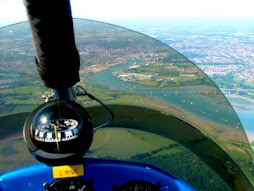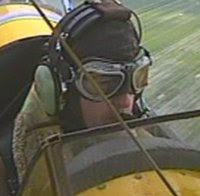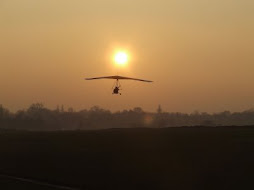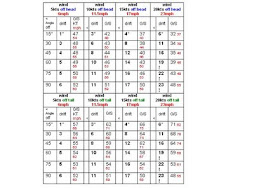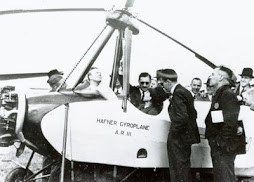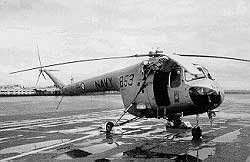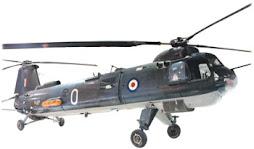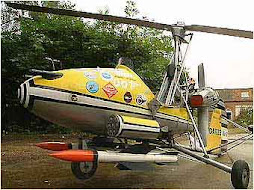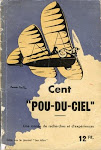A couple of months ago I had pulmonary embolisms in both lungs, which almost killed me and which put me in hospital for a week. I was grounded, which meant not only that I couldn't fly my own plane (never, never call it a plane, Bader!) but also that I couldn't fly to Australia a few days later as planned. My trip was postponed by a month, and after that I spent a fantastic month visiting my sister in Melbourne, camel trecking and camping in the Outback and visiting friends in Darwin.
I am on warfarin now and making good progress. I can fly again, but now my aeroplane (it is an aeroplane, Bader!) is out of permit, so what I really must do in the next week or so is get down to the hangar and do some maintenance on her.
Thursday 24 October 2013
Thursday 21 March 2013
small inputs
Small inputs
and give them time to take effect!
I have now done my first unsupported landing in 3-axis. But I am very much over-correcting because I am used to a slower approach with a relatively rapid succession of large flexwing inputs.
Can't wait to get up again this weekend (if weather allows) to practise my circuits, approaches and landings . . .
Can't wait to get up again this weekend (if weather allows) to practise my circuits, approaches and landings . . .
and must make
small inputs
and give them time to take effect!
Saturday 16 March 2013
Bernouille turned upside down
A year or two ago I saw a film on YouTube which appeared to debunk the Bernouille Principle as a way of explaining the lift of a wing. Student pilots are always taught that an aeroplane flies because of the shape of a wing, which because of its shape experiences negative pressure over its top surface so that it is effectively sucked upwards (or forced upwards by the greater pressure beneath the wing). So this film said, how does that explain the fact that an aeroplane can fly equally well upside down?
I was fascinated and came away excited and confused. The film hadn't persuaded me that Bernouille was wrong, but on the other hand it obviously couldn't be the whole story.
I am reading a book called Stick and Rudder, which has apparently been continuously in print for the last 60 years and is very well regarded. The author, Wolfgang Langewiesche, says it is all due to the angle of attack, and that while Bernouille is no doubt true, it obscures the whole business:
I was fascinated and came away excited and confused. The film hadn't persuaded me that Bernouille was wrong, but on the other hand it obviously couldn't be the whole story.
I am reading a book called Stick and Rudder, which has apparently been continuously in print for the last 60 years and is very well regarded. The author, Wolfgang Langewiesche, says it is all due to the angle of attack, and that while Bernouille is no doubt true, it obscures the whole business:
"Trying to understand the piloting of airplanes by concentrating on Bernouille
and Prantl is like trying to catch on to tennis by studying just exactly
how the rubber molecules behave in a tennis ball"
I have only just started the book, but essentially he says that all flight is about the angle of attack of an inclined plane (surface). So that is why my hand, which is not aerofoil sectioned, rises when I stick it out the car window, or why an aerobatic aeroplane with almost no hump in its wing flies equally well upside down!
Friday 15 March 2013
Stick and rudder
Talking about adverse yaw
with Mike, yesterday, I was made to realise that I only half understood what
causes adverse yaw in a turn. I have been reading what is now a very old flying
manual, as it was written for RAFVR pilots at the start of the war (but on the
premise that aerodynamics do not change). Perhaps their description was too
simplistic, or perhaps I misunderstood it. But blurting out that I understood
this, then going on to mis-describe it in earshot of other pilots was humbling.
I said that adverse yaw was
created when the outside wing, travelling faster than the inside one, suffered
induced drag, so pulled back in the opposite direction to the turn. Mike said
that actually you get more induced drag when the wing is going slower.
Mike explained that yaw is
not a component of speed but of lift, and now it is slowly becoming clear
in my mind, a day later! I am devising a teacher’s way of explaining it to
myself and possibly others (about which, more later).
It needs to be reiterated
that any misunderstanding is my own, not Mike’s, obviously. And also, if I have
not got it right since Mike explained it, that isn’t a fault of his
explanation, but my slowness in getting something. I have always been like
this. I need to go away and think things through, which is what I am doing now.
And remember, this is not a manual I am writing here, it is me playing with
what I am learning, and trying to get some sense out of it.
By patient Q&A, Mike eventually
drew the words “angle of attack” out of me and then went on to show me the
effects on the chord line (leading edge to tip of the aileron) of depressing
the aileron. The increased angle of attack increases that wing’s lift, and it
is the increased lift, not the speed, which creates the drag. On the opposite
wing, the raising of the aileron (raising the rear of the chord line so that it
is pointing down) reduces the angle of attack and therefore reduces its lift,
so there is less induced drag on that wing.
Visually (as well as
technically), there is another aspect to this, which is the direction of the
lift (it is all flooding back to me now, but I must revise all this, as it has
been 5 years since I did my Principles of Flight exam). Lift is perpendicular
to the relative airflow.* So, the outside wing’s lift is pointing backwards,
while the inside wing’s lift is pointing forwards and if I am right, it is
that, too, which causes the direction of yaw. I think what we are saying is that because the
lift is pointing backwards lift drags that wing backwards; drag is the
secondary effect of lift.
So that is where my original
misunderstanding came in. I said that airspeed created drag. Actually, greater
airspeed creates lift and it is the lift which creates drag. Here’s a thought,
maybe it would be more helpful to talk in terms of directions of forces. If the
force perpendicular to the relative airflow is upwards and backwards, it will try to pull
the wing (and the aircraft to which the wing is attached) upwards and backwards
towards that wingtip. And because you want to turn in the opposite direction,
you need something to counter this force, which is where the rudder comes in.
I am getting used to pushing
the stick and rudder in the same direction (stick right, right rudder pedal)
and that doesn’t pose a great problem, conceptually, except on the ground, taxying - where this is opposite to a flexwing's steering). I
have been getting used to using the clinometer (turn and slip indicator), which
is a curved glass tube spirit level with a ball sitting at the bottom in the
middle. In a turn, you have to use the rudder to keep the ball in the middle to
achieve a balanced turn, where the aeroplane is not tending to skid outwards of
the turn or slip inwards of it. When the ball rolls to the left, you have to
apply left rudder to correct this and bring it into balance again. I was
pleased that I got the hang of this.
(My copy of Stick and Rudder, by Wolfgang Langewiesche - recommended by Katie - just arrived. Am off to do some reading now)
* Mike just rang to say that people in the clubhouse have just been discussing what I wrote and he asked me to explain what I meant by saying that lift was perpendicular to angle of attack. Oh dear! I got that bit wrong. I have changed it to perpendicular to the relative airflow. "I will leave you to ponder that one", he said.
:)
A friend of mine who was on the same Masters programme as me at Imperial College, and who is very scientific, and was in fact a curator at the Science Museum said, after reading this, "Blimey, and I thought riding a bike was difficult!"
* Mike just rang to say that people in the clubhouse have just been discussing what I wrote and he asked me to explain what I meant by saying that lift was perpendicular to angle of attack. Oh dear! I got that bit wrong. I have changed it to perpendicular to the relative airflow. "I will leave you to ponder that one", he said.
:)
A friend of mine who was on the same Masters programme as me at Imperial College, and who is very scientific, and was in fact a curator at the Science Museum said, after reading this, "Blimey, and I thought riding a bike was difficult!"
Friday 8 March 2013
Our pathetic flying documents
With my licence revalidation due soon, I had an almighty search for my medical certificate yesterday. Took me two hours to find it. I was looking for the old style pink card, forgetting that the current one is an online download. I don't know how it slipped out of my licence's wallet, but because it is now just a flimsy bit of A4 it ended up with a load of receipts in a paperwork tray.
What a relief to find it. But it does highlight for me how flimsy our paperwork is. Just look at our pilot's licences. After all our hard work, you'd expect a document that really looked the part....something like an old fashioned, crested passport would be about right!
When I researched my dissertation on Raoul Hafner, looking through his private papers I found his autogyro licence, issued in 1933 and it was hard bound with fine scrollwork: Federation Aeronautique Internationale British Empire....lots of fine writing both in English and French, with personal details and on the page opposite, Hafner's photo and large, proud signature. It was a worthy document, unlike the pathetic thing we carry - and are forever in danger of losing.
What a relief to find it. But it does highlight for me how flimsy our paperwork is. Just look at our pilot's licences. After all our hard work, you'd expect a document that really looked the part....something like an old fashioned, crested passport would be about right!
When I researched my dissertation on Raoul Hafner, looking through his private papers I found his autogyro licence, issued in 1933 and it was hard bound with fine scrollwork: Federation Aeronautique Internationale British Empire....lots of fine writing both in English and French, with personal details and on the page opposite, Hafner's photo and large, proud signature. It was a worthy document, unlike the pathetic thing we carry - and are forever in danger of losing.
Thursday 7 March 2013
another Dragonfly's big end bearing failure
Yesterday I heard of another big end bearing going on a Dragonfly, which makes three (including mine - and I didn't know about the one before mine when I purchased my Dragonfly, so there could easily be others).
I had been telling the pilots at Chatteris about the kicking my confidence took in my first year of being licenced when I had six engine failures in the Dragonfly, the last of which was never diagnosed by Paul Bailey, who ended up just replacing all the ancillaries on the engine. Its new owner gets lots of joy out of it, but he ought to, he has practically a new engine.
For all that the Dragonfly could be a wonderful fly, I will never be able to forgive the Bailey engine for really shaking my confidence and for having put my girlfriend off flying microlights altogether.
I had been telling the pilots at Chatteris about the kicking my confidence took in my first year of being licenced when I had six engine failures in the Dragonfly, the last of which was never diagnosed by Paul Bailey, who ended up just replacing all the ancillaries on the engine. Its new owner gets lots of joy out of it, but he ought to, he has practically a new engine.
For all that the Dragonfly could be a wonderful fly, I will never be able to forgive the Bailey engine for really shaking my confidence and for having put my girlfriend off flying microlights altogether.
Flying a C42 with Katie Denham
 |
| Not the school C42, but one Katie has a share in. |
Katie has a very calm, confident but unassuming manner and I was immediately at my ease, and almost from the off, "You have control".....and I was taxiing to runway 06. This, as you will know, is the first mental conversion required of a flexwing pilot, as the controls are reversed. Steering a trike is like steering a children's tricycle; it is direct. But a 3 axis tricycle nose wheel control is connected to the rudder, so you push right to go right. So I did it rather too slowly at first and I think Katie thought we'd never get to the runway, so took back control for a short while, then gave it back for the last 25 metres. On the taxi back I was much more confident. The trick to getting it straight is to put yourself in the centre and steer yourself rather than the nose of the aircraft, and that came naturally to me; and actually, push right, go right makes real sense. Get the throttle settings right, and I will crack it.
Once airborne the first thing I realised very quickly was how light the controls are compared to flexwing, where you are correcting all the time, and dealing with often quite strong upper body movements; so much so, that Lizzie's instructor did wonder how easily she'd manage it (though, in fact, she was a natural). Katie told me to hold the stick with thumb and fingers either side of it, rather than wrapping fingers round it, as I did at first. Your hand sort of brackets the stick, a bit like a tuning fork with the stick between the prongs. This will mean greater sensitivity, but presumably is also to stop you nervously flying nose high and stalling.
We did Ex4....controls familiarisation. I learnt about setting flaps...about the ballooning effect and how to counter it, bringing the nose down to the right attitude.The reverse, taking off flaps, was trickier because I did not realise quite how snappy the spring would be, so let the handle forward, releasing the loads, far too dramatically. But with a few tries that improved. Of course we don't have flaps on trikes, so this was all new.
I learnt a lot about setting the trim, about the nose attitude of the aeroplane, and spent lots of time looking at the airspeed indicator and the revs. The C42 trim settings are done with switches on the top of the stick, which incidentally is centrally mounted and shared. Stick forward -front button, stick back -back button. All very logical really. Trim is almost inconsequential on the Quantum, so it is some time since I thought about it, but setting it up on the C42 was just the same as doing it on the GT450. Lovely being able to do it with tiny switch inputs on the stick rather than a great big knob on the side of the A-frame.
All climbing and descending was much as you'd expect in any aircraft, PAT and APT, etc. I was pleased to be able to go straight into that without embarrassing myself.
One thing that did surprise me was that almost nothing was done with the rudder* (see update below for clarification), and not just because I was being introduced to it slowly, either. All turning was done with the stick, using the aircraft's differential ailerons. This made the operation very much simpler than flying the Tiger Moth, for instance. Katie demonstrated the way the nose can drop down to the right on a turn and how to counter it- but it didn't seem a great problem.
I loved the challenge and focus of the hour, which passed very quickly; And despite it rushing past, I felt that we covered an awful lot. I really enjoyed being a student, but like being a post-grad again I had the advantage of knowing all the basics already, so that progress was fairly rapid, leaving me feeling confident about doing a conversion, which really does have to be the next thing. Of course, lots of that confidence has to be down to Katie, whose delivery is very clear and reassuring. I did ask her how long she thought conversion would take, and she was professionally reticent to give a number, but my impression is that it is probably a very affordable 10-12 hours.
(This was a lesson, not a joy ride, so I didn't take my camera up, and the aeroplane was back in the air after my lesson before I thought to take any pictures, so I took pics of the one Katie has a share in)
..........................................
*Update
Katie has now read what I put and has got back to me with some feedback, which she has said I may quote:
"I can see that I didn't emphasise the use of rudder clearly,
it is important in the C-42 but use of it is much more subtle than in the AX
series where you need a bootful of rudder just to get the thing to turn.
However, most flex wing pilots soon get used to the rudder. The two things that
seem to be the biggest issues are learning to fly by power and attitude rather
than feeling airspeed directly and being too heavy handed on the controls;
flying with a light touch is vital, especially when landing a 3 axis as you
will be able to feel the aircraft slowing down during the hold off and feed in
more and more back pressure. A vice-like grip makes this almost impossible, but
I don't think you will have a problem with that.
There is so much to learn with 3 axis, I think it's more of an art than flex wing flying, converting is just the beginning...."
There is so much to learn with 3 axis, I think it's more of an art than flex wing flying, converting is just the beginning...."
Monday 18 February 2013
Yakkity Yak, Yakkity Yak!
I forgot to mention that over Fram we were buzzed, ten o'clock high, by an all-silver Yak (3M, I think) with a red star on the fuselage, which turned and came past again. You can see why I thought it was a Spit at first...until it banked and I saw its wing shape, which looked oddly like a Hurricane's. We then thought the fuselage, with that wing, made it a Mustang, which would have been much more exciting than a Yak, of course, but it was still a real highlight sharing airspace with this character.
Just found this on Google and it looks like the very one. It was seen at Duxford last year in the Flying Legends show, so there is every chance it is the one we saw.
Sunday 17 February 2013
Took Dave Flying
 |
| Dave and I teach at the same school. He is Head of Science. |
I did a check flight before taking Dave up and that circuit on its own was glorious.
click images for clarity
We hovered over some very grand houses
Altogether a superb day's flying!
Monday 11 February 2013
my diversionary track
I have been looking at satellite images of the area around the airfield to try to work out where I flew when I couldn't pick out the mast because of low cloud and haze. I didn't want to fly straight towards the mast from Debenham in case I didn't spot it soon enough to avert disaster, so I diverted to the right and tried to pick it up on my left. This course took me north of the field, but it was tricky orientating myself.
 I spotted the smaller tower (the Repeater Station at Brockford) and used it as a way point, turning back on myself and trying to rotate the shadow of the former aerodrome below me, until I spotted the hangar and the runway off to my right. But it was the tower at Brockford which got me back on track.
I spotted the smaller tower (the Repeater Station at Brockford) and used it as a way point, turning back on myself and trying to rotate the shadow of the former aerodrome below me, until I spotted the hangar and the runway off to my right. But it was the tower at Brockford which got me back on track.

click images to increase size
 I spotted the smaller tower (the Repeater Station at Brockford) and used it as a way point, turning back on myself and trying to rotate the shadow of the former aerodrome below me, until I spotted the hangar and the runway off to my right. But it was the tower at Brockford which got me back on track.
I spotted the smaller tower (the Repeater Station at Brockford) and used it as a way point, turning back on myself and trying to rotate the shadow of the former aerodrome below me, until I spotted the hangar and the runway off to my right. But it was the tower at Brockford which got me back on track.
Quite frightening how close you can be to home before you pick up familiar references, though.
Sunday 10 February 2013
Finally! Flew again after two months grounded by weather
It wasn't for long, but yesterday I finally got back in the air and I feel fantastic for having done so. I was really pleased by how easily the engine started and relieved to find that the ground, though sodden, was firm enough to taxi on and the main runway firm enough to land on safely.
The only real negative was the cloud base, which forced me down below a thousand feet (especially on the return leg) and much of the time from Framlingham I couldn't see the mast; in fact I couldn't even see Debenham much of the way, picking my way along 269 degrees, just trusting that I'd hit the town eventually, which I did, of course. But it is disconcerting being two and a half minutes from home, flying beneath the Wattisham panhandle, so around 800', and still not being able to see a mast which is two hundred feet taller!! But eventually it emerged and I found that I was slightly too far north of it (and alarmingly too close to the smaller mast just by the A140), which meant that I then made a very conspicuous cross wind approach; the hang gliders on the ground will have seen me for longer, and waited for me before launching.
I am so glad that I was free yesterday on the first flyable day in ages, with snow forecast for the week ahead.
I am glad that I seized the day.
The only real negative was the cloud base, which forced me down below a thousand feet (especially on the return leg) and much of the time from Framlingham I couldn't see the mast; in fact I couldn't even see Debenham much of the way, picking my way along 269 degrees, just trusting that I'd hit the town eventually, which I did, of course. But it is disconcerting being two and a half minutes from home, flying beneath the Wattisham panhandle, so around 800', and still not being able to see a mast which is two hundred feet taller!! But eventually it emerged and I found that I was slightly too far north of it (and alarmingly too close to the smaller mast just by the A140), which meant that I then made a very conspicuous cross wind approach; the hang gliders on the ground will have seen me for longer, and waited for me before launching.
I am so glad that I was free yesterday on the first flyable day in ages, with snow forecast for the week ahead.
I am glad that I seized the day.
Subscribe to:
Posts (Atom)





b.jpg)
.JPG)
b.jpg)
b.jpg)
c.jpg)





